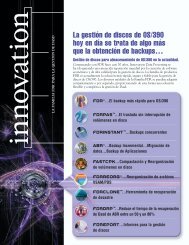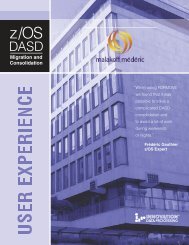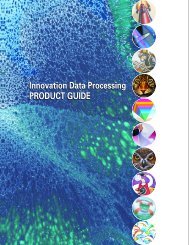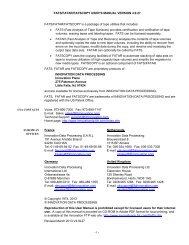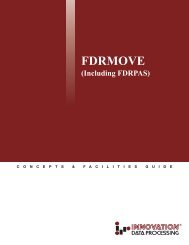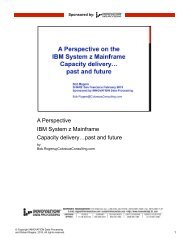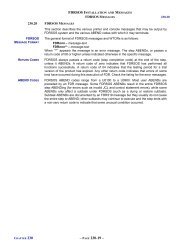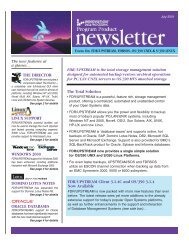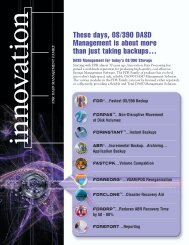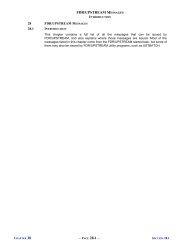FDR V54L78 - Innovation Data Processing
FDR V54L78 - Innovation Data Processing
FDR V54L78 - Innovation Data Processing
You also want an ePaper? Increase the reach of your titles
YUMPU automatically turns print PDFs into web optimized ePapers that Google loves.
<strong>FDR</strong>309<br />
Reason:<br />
<strong>FDR</strong>310<br />
Action:<br />
Reason:<br />
<strong>FDR</strong>311<br />
Reason:<br />
MESSAGES AND CODES<br />
MESSAGES FROM <strong>FDR</strong>, DSF, AND ABR (<strong>FDR</strong>NNN) 100.3<br />
DDNAME=dddddddd,VOL=SER=vvvvvv NOT ELIGIBLE FOR AUTO BACKUP [I/O<br />
ERROR COMP=cccc]<br />
The disk volume named in the message has not been initialized for ABR processing; the<br />
ABR Model DSCB was not found in the VTOC of the volume. If the text “I/O ERROR”<br />
is displayed, an error occurred attempting to read the ABR Model DSCB and “cccc” is<br />
the return code from the OBTAIN SVC.<br />
To perform ABR processing (other than simulation and Application Backup) for this volume,<br />
you must initialize it for ABR processing with program <strong>FDR</strong>ABRM (Chapter 50 “<strong>FDR</strong>ABR<br />
Volume Backups”) or the ABR ISPF dialogs (panel A.I.8). If operand NOINIT is specified,<br />
ABR allows a simulation of the ABR function (command SIM) to be done.<br />
MAXIMUM NUMBER OF CYCLES/DATE EXCEEDED--<strong>FDR</strong> DUMP FORCED ON VOL=vvvvvv<br />
An ABR Volume Backup requested an incremental backup, but a full-volume backup is<br />
being forced instead, because:<br />
❖<br />
❖<br />
❖<br />
❖<br />
❖<br />
The number of cycles (incremental backups) within the current generation for this<br />
volume had reached the maximum (63).<br />
The most recent full-volume backup of this volume had expired, according to the<br />
expiration date stored in the ABR Model DSCB. Specify DATEP=NONE on the<br />
DUMP statement to bypass this check and create the incremental backup.<br />
The DUMP statement specified TYPE=AUTO, and the number of auto cycles<br />
created in the current generation was equal to or greater than the maximum<br />
specified in the ABR Model DSCB on the volume.<br />
This was the first volume backup after a full volume restore with PGM=<strong>FDR</strong>, or<br />
with PGM=<strong>FDR</strong>ABR using the TAPEDD option.<br />
This was the first volume backup after the volume was initialized for ABR processing.<br />
<strong>FDR</strong> function DSN=dsname status<br />
TO NEWN=newdsname<br />
ON VOLSER=volser UNIT=device STORCLAS=sc<br />
MGMTCLAS=mc DATACLAS=dc<br />
CLUSTER=cluster NEWC=newcluster<br />
The non-VSAM data set or VSAM component “dsname” was SELECTED, DUMPED,<br />
RESTORED, COPIED, or MOVED. This message is always printed on data set<br />
operations, and is printed on full-volume backups if PRINT=DSN is specified.<br />
Message <strong>FDR</strong>392 may be printed instead for data set dumps. On restore and<br />
copy/move operations “status” also indicates:<br />
ALLOCATED – The data set was allocated by <strong>FDR</strong>; if absent, a pre-allocated data<br />
set was overlaid.<br />
CATALOGED – The data set was cataloged by <strong>FDR</strong>; if absent, either cataloging<br />
was not requested or the catalog request failed (see message <strong>FDR</strong>334).<br />
LOGICAL – A logical restore was done, used when restoring to an unlike disk type,<br />
or when re-blocking.<br />
INSTANT – A hardware facility was used to quickly copy data in an <strong>FDR</strong>COPY step.<br />
This occurs only if you are licensed for <strong>FDR</strong>INSTANT. On an IBM RVA or<br />
Oracle StorageTek SVA/Iceberg with the SnapShot feature, SnapShot was<br />
used. On an EMC Symmetrix, an internal EMC copy function was used.<br />
Both the input and output volumes must be in the same RVA/SVA/Iceberg<br />
or EMC subsystem.<br />
If the data set or component is being restored to a new name, the line containing<br />
“newdsname” is displayed.<br />
“volser” defines the volume serial of the disk where it was restored, and “device”<br />
identifies the disk type and model (e.g., 3390-3). If the output data set is<br />
SMS-Managed, the SMS classes assigned to the data set are displayed<br />
(management class and data class may be “(NULL)” if not assigned).<br />
CHAPTER 100 – PAGE 100-60 –



